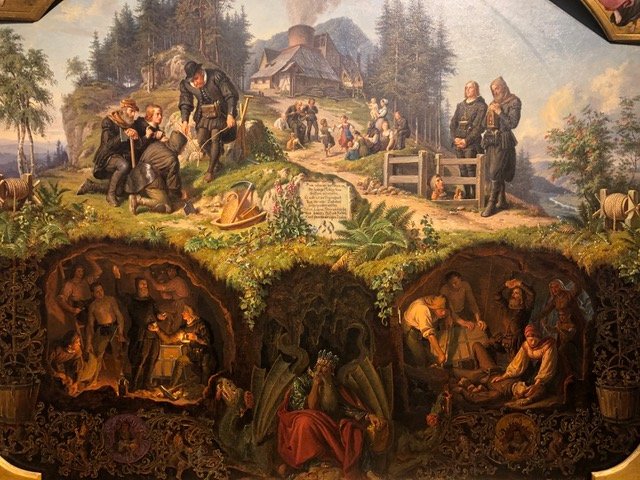Here is a summary of the recent April 25, 2020 Zoom meeting in Fair Oaks.
Meeting Summary
After a period of “meet and greet” and sharing some personal news and news of the community, we began the meeting with a verse. The verse chosen for this meeting comes from Heinrich von Ofterdingen. I included it at the end of this email, along with a free poetic translation.
Marion then gave a presentation on Märchen. Marion presented how important and formative these Märchen were for her as a child growing up in Germany. Using a series of illustrations taken from all manner of romantic Märchen (art tales or folk tales), including Arabian Nights and stories from old India, she emphasized how these Märchen inspired her imagination and have lived in her for her entire life, and she encouraged us to add artistic, playful exercises to our study of Novalis and his times. For example, if we were meeting in a physical location, we might wish to do an artistic exercise with the color blue — perhaps with watercolors — exploring the motif of the blue flower.
Marion emphasized that the human being has a need for stories and tales, and this need goes far back in time. Other examples are Aesop’s Fables. She mentioned that Goethe loved the Arabian Nights and that he kept a copy close. After emphasizing the transformative power of Tales, Marion pointed out that so-called fairy tales have origins in pre-Christian centuries; there is a direct lineage to the Buddhist canon, Pali and Sanskrit; she underscored the enormous impact that the Arabian Nights had on the European imagination; she referenced Christian Rosenkreutz and the Rosicrucian usage of symbols, tales, and illustrations as inspiration for cultural, personal, and spiritual renewal; she referenced that Christian Rosenkreutz traveled to the East; she helped us better situate and contextualize the Märchen in Heinrich von Ofterdingen. Ludwig Tieck received mention in the discussion — Tieck as a splendid practitioner of the genre — as well as Wieland, Hauff, and others.
We discussed the curious imaginative overlap between mining and Märchen We looked at a picture from the Crocker Art Museum that makes this overlap evident. I included a copy of the picture above. Patricia inspired a lively discussion of the romantic figuration of mines and mining. This led us to a consideration of Friedrich Benesh’s monograph Der Turmalin. I pulled my edition off the shelf and shared some photos as best as I could (it’s quite the tome!), along with representations of mining from the Middle Ages and the eighteenth century. Alice drew our attention to the redemptive power of poetry. Novalis, much like Goethe (mines of Ilmenau — silver and copper), did not choose to emphasize the early-capitalist exploitative and environmentally destructive aspects of mining (those “dark Satanic Mills” that Blake rails against); they and others at that time turned attention to poetry and the redemptive power of the imagination.
Gayle shared a poem by Charles Simic, and I included this poem as one of the attachments below. The themes and imagery in Simic’s poem are in a direct line of descent, thematically and imaginatively, from Novalis and his contemporaries. In previous meetings, we discussed the Paracelsus term “Lumen Naturae,” and I drew attention again to those earlier discussions. I’m sure we will revert to this idea of the “light of nature” or the “light that indwells darkness” many times as we continue our journey to Augsburg. In fact, for our next meeting, we will continue our discussion of Chapter Five, the mining chapter, because there are many themes and aspects that we could not discuss yesterday. These include: the Orphic mysteries and perhaps a closer consideration of the quote that might serve as the central meditation of the chapter:
“You are well nigh inverted astrologers,” said the hermit; “as they ceaselessly regard the sky, wandering through its immeasurable spaces, so do you turn your gaze to the earth, exploring its construction. Astrologers study the forces and influences of the stars, while you are discovering the forces of rocks and mountains, and the manifold properties of earth and stone strata. To them the higher world is a book of futurity; to you the earth is a memorial of the primeval world.”
In the earlier meeting invitation email, I included a quick summary overview of the novel’s chapters. Some of you said that this was useful, so I am attaching it below, along with the other attachments. These other attachments include a copy of Steiner’s Last Address and Tieck’s notes on how his friend Hardenberg intended to finish the novel Heinrich von Ofterdingen — pages that are missing from the Hilty translation we are using.
Our next meeting on Saturday May 2 is Friedrich von Hardenberg’s birthday! We are planning a little celebration. Send me your ideas!
For a brief summary of the novel Heinrich von Ofterdingen, click this link below:
Quick Summary of “Heinrich von Ofterdingen” PDF
“Every sickness is a musical problem; the cure is the musical solution.”
— Novalis

